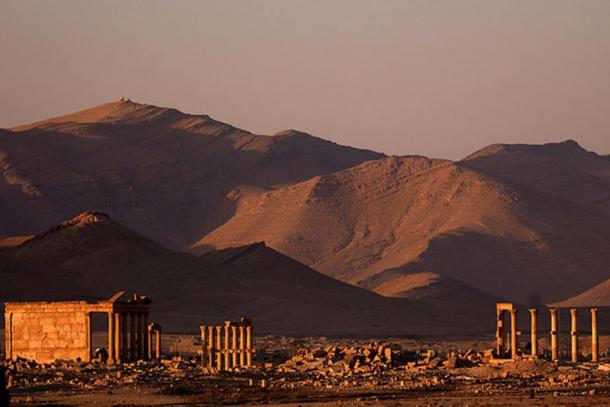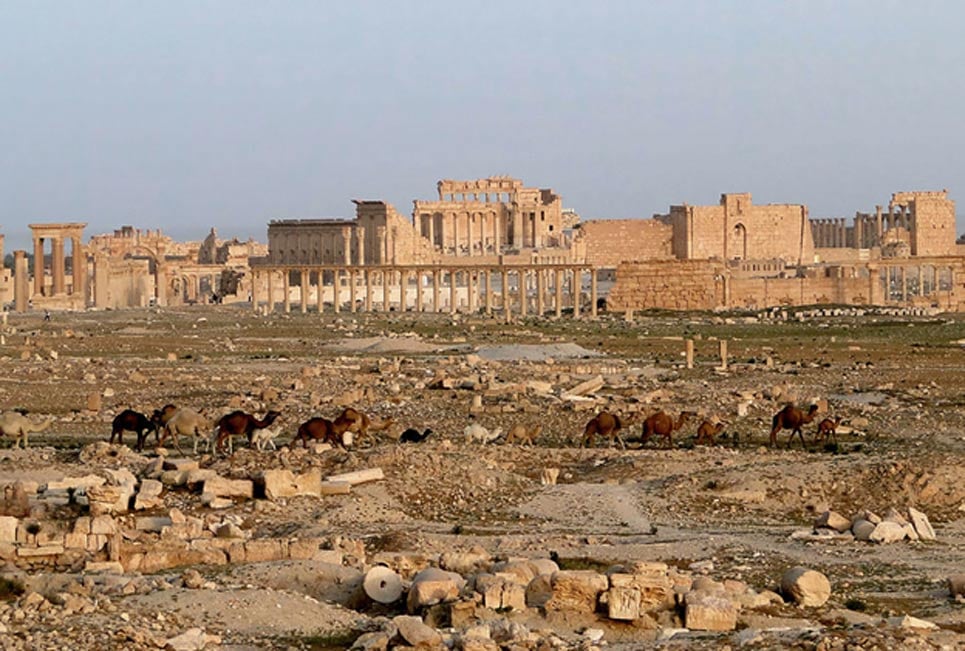The Ancient City of Palmyra: The Pearl of the Desert
Palmyra is an ancient city located in modern Syria which served as the capital of the Palmyrene Kingdom during the 3rd century AD. In May 2015, this city made the headlines and grabbed the attention of the world when it was seized by the militant group known as ISIL/ISIS. The group then proceeded to destroy a number of important ancient structures in the city, including the Temple of Bel and the Monumental Arch (known also as the Arch of Triumph or the Arch of Septimius Severus).
In late March 2016, Palmyra was recaptured by the Syrian Army. Preliminary assessments have revealed that the historical site is still largely intact, and authorities are now beginning to make more detailed evaluations regarding the damage the city has suffered over the last 10 months.

A view of Palmyra in 2006. (CC BY 2.0)
Palm Tree City Prospers
Palmyra is located in the Syrian Desert to the northeast of the country’s capital, Damascus, in what is today the Homs Governorate. The city’s name is said to have been the Greek translation of its original Aramaic name, Tadmor, which means ‘palm tree’.
Palmyra was first been mentioned in the archives of Mari, which date to the 2nd millennium BC. Additionally, Palmyra was mentioned in the Bible as a desert city fortified by King Solomon. Nevertheless, it was only around the 3rd century BC that the city started to acquire prominence.
During this time, a road that passed through the city became one of the main trade routes that connected the East and the West. Being an oasis settlement in the middle of the desert, Palmyra provided shelter, rest, and sustenance for the travelling merchants and their caravans. As a consequence, Palmyra soon prospered. During the Hellenistic period, Palmyra remained as an independent city and continued to prosper, thanks to its allegiance to the Seleucid Empire, the regional superpower at that time.

A 2010 image of the Agora in Palmyra. (CC BY SA 3.0)
Palmyra and the Roman Empire
Following the fall of the Seleucid Empire, the province of Syria was established by Pompey in 64 BC. Still Palmyra successfully maintained its independence, though it would eventually become part of the Roman Empire as well.
- Zenobia, the Warrior Queen of Palmyra, Syria
- Ten Powerful and Fearsome Women of the Ancient World
- Tomoe Gozen - A fearsome Japanese Female Warrior of the 12th Century
In 41 BC, an attempt was made by Mark Antony to conquer Palmyra. This undertaking failed, however, as the Palmyrenes had received news about the impending attack, and were able to flee to the other side of the Euphrates. This is also seen as an indication that at that point of time, the Palmyrenes were likely to have been nomads.

Bust of Mark Antony in Vatican City. (Public Domain)
During the reign of Tiberius, Palmyra became part of Roman Syria, was proclaimed a free city by the Emperor Hadrian, and then transformed into a colony during Caracalla’s reign. Over these centuries, Palmyra continued to prosper due to its position on the trade route that connected the Roman Empire with the East. During the 3rd century AD, the rise of the Sassanian Empire threatened the eastern part of the Roman Empire, and had a negative impact on the prosperity of Palmyra.
The Palmyrene Kingdom
Nevertheless, the Palmyrenes seemed to have made the most out of their circumstances. This crisis saw the rise of Septimius Odaenathus, commonly regarded as the founder of the Palmyrene Kingdom. During the conflict between the Roman and Sassanian Empires, Odaenathus remained loyal to Rome, and was even able to inflict a serious defeat on the Sassanians as they were about to cross the Euphrates.
- The Disappearing Petroglyphs of the UAE: An ongoing and avoidable tragedy
- Marcus Aurelius: Life of the Famous Roman Emperor and Philosopher
- Ancient Jewish necropolis in Israel given worldwide recognition

A bust that may represent Odaenathus. (CC BY SA 4.0)
Following his death, the kingdom was inherited by his son, Vaballathus, under the regency of Zenobia, Odaenathus’ widow. The newly formed kingdom managed to carve out a considerable chunk of Roman territory for themselves - until they were defeated by the Emperor Aurelian.

The coinage of Vaballathus also shows, at the beginning, portraits of Aurelian. This means that Aurelian and Vaballathus had recognized each other. (Public Domain)
Blending the East and West
One of the most significant aspects of Palmyra is its unique blend of Eastern and Western traditions. For example, it has been written that Palmyra “was the only publicly bilingual city in the Roman Near East”, the two languages being Greek and Palmyrene Aramaic. This aspect can be seen in the many inscriptions found within this ancient city.
In addition, the fusion of East and West can also be seen in the art and architecture of Palmyra. The Temple of Bel may be used as an illustration of this. This was Palmyra’s largest and most important temple. Although the Temple of Bel looked like a typical Eastern temple, it also incorporated columns like those found in Roman temples.
A digital reconstruction of the Temple of Bel, along with three other ancient buildings in Palmyra, can be found in an online repository of 3D images published into the public domain to digitally reconstruct the city’s ancient sites. The website is called #NEWPALMYRA and it aims to “source archaeological and historical data, share it with the community, and output art exhibitions, salons, and creative works using this data to carry the rich history of Palmyra forward to new generations.”
Featured image: View of Palmyra in 2010 showing the Temple of Bel. Source: CC BY SA 3.0
By Wu Mingren
References
Bailey, D., 2015. Palmyra: Islamic State's demolition in the desert. [Online]
Available at: http://www.bbc.com/news/world-middle-east-34294287
Department of Ancient Near Eastern Art, The Metropolitan Museum of Art, 2010. Palmyra. [Online]
Available at: http://www.metmuseum.org/TOAH/hd/palm/hd_palm.htm
Millar, F., 1993. The Roman Near East, 31 B.C. - A.D. 337. London: Harvard University Press.
Romey, K., 2016. Why Palmyra, Recently Liberated, Is a Historical Treasure. [Online]
Available at: http://news.nationalgeographic.com/2016/03/160328-Palmyra-Syria-Islamic-State-ISIS-archaeology-Rome/
Sacred Destinations, 2016. Palmyra. [Online]
Available at: http://www.sacred-destinations.com/syria/palmyra
The BBC, 2016. Syria civil war: Palmyra damage in pictures. [Online]
Available at: http://www.bbc.com/news/world-middle-east-35909456
UNESCO, 2016. Site of Palmyra. [Online]
Available at: http://whc.unesco.org/en/list/23



















